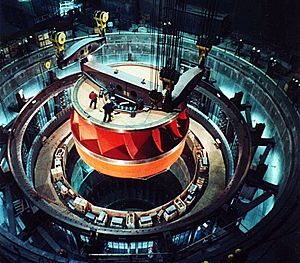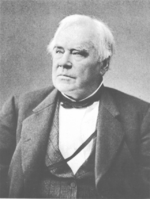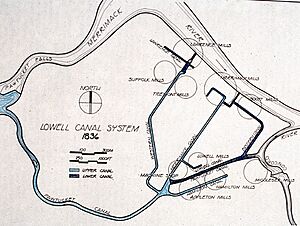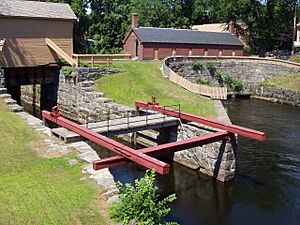James B. Francis facts for kids
James Bicheno Francis (born May 18, 1815 – died September 18, 1892) was a talented British-American civil engineer. He is famous for inventing the Francis turbine, a special type of water wheel.
Contents
Early Life and Engineering Start
James Francis was born in South Leigh, England. He began his engineering journey very young, at just seven years old. He worked with his father on railway and harbor projects in South Wales.
When he was 18, in 1833, James moved to the United States. His first job was helping railway engineer George Washington Whistler Jr. in Stonington, Connecticut. A year later, James and Whistler moved to Lowell, Massachusetts. At 19, James became a draftsman (someone who draws detailed plans) for the Locks and Canal Company. Whistler became the chief engineer there.
In 1837, Whistler left to work on railroads in Russia. Before he left, he chose Francis to be the new chief engineer. James also bought Whistler's house. That same year, James married Sarah W. Brownell. They had six children together.
Managing Water Systems
In 1841, James Francis took on a big project. He had to figure out how much water each factory was using from the company's canals. His skills impressed everyone. In 1845, he was made "Manager of Locks and Canals."
As manager and chief engineer, Francis built the Northern Canal and Moody Street Feeder. These canals were finished in the late 1840s and early 1850s. They made the Lowell canal system 5.6 miles long. This greatly increased the power for the city's many factories.
Francis also helped with other water projects across the country. He advised on building the Quaker Bridge Dam in New York. He also helped with the dam at Saint Anthony Falls on the Mississippi River.
Fire Safety Innovation
In 1845, Francis created one of the first fire sprinkler systems in the United States. His system would flood an entire building to put out a fire. Later, in 1875, Henry S. Parmelee invented a better sprinkler head. This new head would only spray water from one spot at a time.
The Francis Turbine
Francis became very interested in turbines, which are machines that use moving water to create power. He worked with another engineer, Uriah A. Boyden, to make turbines better. In 1848, Francis and Boyden greatly improved the turbine. This new design became known as the Francis turbine.
The Francis turbine was much more powerful than older designs. In 1855, Francis shared his discoveries in a book called "Lowell Hydraulic Experiments."
Protecting Cities from Floods
In 1850, Francis ordered a huge gate to be built over the Pawtucket Canal. This "Great Gate" was meant to protect the factories in downtown Lowell from big floods. People called it "Francis's Folly" because they didn't think it would ever be needed.
But less than two years later, in 1852, the gate saved Lowell from a terrible flood. It also protected the city in 1936, 1938, 2006, and 2007. The gate stopped the Merrimack River from flooding the canal system. For saving the city, Francis received a large silver pitcher and a tray.
In 1886, Francis worked with two other engineers to study flood prevention in Boston. They published their findings in "Prevention of Floods in the Valley of Stony Brook." This detailed study looked at areas like Forest Hills and Hyde Park that often flooded.
Later Career and Legacy
Francis was a very active member of the Lowell community. He served as an alderman (a local government official) from 1862 to 1864.
In 1865, he published research on how strong cast iron was when used in building columns.
In 1874, Francis helped investigate why the Mill River dam in Massachusetts broke. The committee found that the dam was poorly built by people who were not professional engineers.
Francis also created scientific ways to test water-powered machines. He was a founding member of the American Society of Civil Engineers and became its president in 1880.
The Francis Formula
In 1883, Francis finished his important work on calculating how fast water flows. This became known as the Francis equation or Francis formula. It is used in fluid dynamics to measure water flowing over a weir (a small dam).
The equation looks like this: 
Here's what the letters mean:
- Q is the amount of water flowing in cubic feet per second.
- L is the length of the weir in feet.
- h1 is the height of the water above the top of the weir.
Francis worked for the Locks and Canal Company his whole career. He retired in 1884 at age 69 but stayed on as a consultant. His son, James Jr., took over as chief engineer. James Francis spent his last years with his family in his home on Worthen Street. This house is now the Whistler House Museum of Art.
In 1889, Francis was part of a committee that looked into the cause of the Johnstown Flood. This disaster happened when the South Fork Dam broke, killing over 2,200 people.
James Francis died on September 18, 1892, at 77 years old. He is buried in Lowell Cemetery under a large stone pillar. This pillar represents the stones used to build the canals he worked on.
Honors and Recognitions
Many things are named after James B. Francis to honor his contributions to engineering:
- The James B. Francis College of Engineering at the University of Massachusetts Lowell.
- The Francis Gate in Lowell, Massachusetts.
- The Francis turbine, the water turbine he improved.
- The Francis system, an early type of sprinkler system.
- The Francis formula, used to calculate water flow over dams.
How the Francis Turbine is Used Today

Today, the Francis turbine is the most common type of water turbine in the world. It is used in many large hydroelectric dams, including China's Three Gorges Dam. This dam is one of the largest power stations in the world.
Since 1900, the Francis turbine has been used in almost every hydroelectric dam. It helps generate nearly one-fifth of all the world's electricity!
Here are some famous dams that use Francis turbines:
- Älvkarleby Hydroelectric Power Station (Sweden, 1911)
- Hoover Dam (Nevada/Arizona, 1936) – once the world's largest hydroelectric power station.
- Grand Coulee Dam (Washington, 1942) – the largest power station in the United States.
- Dez Dam (Iran, 1963)
- Gordon Dam (Tasmania, 1978)
- Dalešice Hydro Power Plant (Czech Republic, 1978)
- Robert-Bourassa generating station (Canada, 1981)
- Itaipu Dam (Brazil/Paraguay, 1984) – the largest power station in the Americas.
- Victoria Dam (Sri Lanka, 1985)
- Jinping-I Dam (China, 2013) – the tallest dam in the world.
See also
- 1868 Massachusetts legislature




